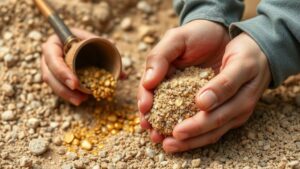Using Pendulum Dowsing to Isolate Specific Ore Veins in Complex Geology
Using Pendulum Dowsing to Isolate Specific Ore Veins in Complex Geology
Pendulum dowsing, also known as divining or dowsing, is an age-old practice that has seen a resurgence in recent years, particularly in the field of mineral exploration. This article delves into how pendulum dowsing can be effectively used to isolate specific ore veins within complex geological formations, integrating both traditional knowledge and contemporary scientific understanding.
The Basics of Pendulum Dowsing
Pendulum dowsing involves the use of a suspended pendulum to detect energy or vibrations that are believed to emanate from underground materials. The dowsing rod moves in response to subtle changes in energy, allowing the dowser to pinpoint areas of interest. Basic principles include:
- Basic Equipment: A pendulum (which can be a simple weight attached to a string) is used by the dowser.
- Visualization: The dowser often visualizes the substance they are seeking, guiding the pendulums response.
Scientific Foundation
While often dismissed by skeptics, some research suggests that pendulum dowsing could operate within the parameters of certain scientific principles, such as the ideomotor effect. This phenomenon occurs when an individual subconsciously moves an object based on thoughts or expectations, which could explain some successes attributed to dowsing.
Geological Complexities
Understanding the geology of a given region is critical to successful dowsing. Complex geological formations may include:
- Fault Lines: Natural breaks in the Earths crust can change the distribution of ores.
- Igneous Intrusions: Volcanic activity that affects mineral deposits.
- Metamorphic Processes: Changes in rock types can lead to ore concentration.
Identifying these features visually and through geological mapping is essential for dowsers to successfully locate ore veins.
Case Studies: Real-World Applications
Several case studies highlight the potential use of pendulum dowsing in mineral exploration:
- Example 1: In the 1990s, a group of dowsers in South America successfully used pendulum dowsing techniques to identify gold veins. Through targeted dowsing sessions informed by geological mapping, they were able to provide drill locations that returned promising results.
- Example 2: An exploration team in Canada utilized pendulum dowsing in tandem with geophysical surveys. The pendulum helped identify specific drill sites, leading to the discovery of high-quality silver deposits.
Best Practices for Effective Dowsing
To maximize the effectiveness of pendulum dowsing in isolating ore veins, practitioners should follow these best practices:
- Initial Training: Engage in formal training or workshops to learn the fine art of dowsing.
- Understanding Geology: Gain a foundational knowledge of the local geological setting to inform the dowsing process.
- Faithfulness to Methodology: Follow established dowsing protocols to ensure consistency.
Addressing Common Concerns
Critics of pendulum dowsing often raise concerns regarding its reliability. Addressing these concerns can enhance credibility:
- Scientific Scrutiny: Encourage further scientific investigation and controlled studies to document the effectiveness of dowsing practices.
- Case Documentation: Maintain detailed records of successful dowsing attempts to bolster claims.
Conclusion and Actionable Takeaways
Pendulum dowsing presents an intriguing blend of traditional practice and potential scientific application. For those looking to incorporate dowsing into their mineral exploration efforts, understanding geological complexities and following best practices is crucial. Also, actively documenting and researching can provide insights that further establish dowsings place within modern exploration techniques.
In summary, pendulum dowsing, when combined with geological knowledge and careful methodology, can yield promising results in the search for specific ore veins in complex geological settings. By embracing a balanced approach that respects both traditional practices and scientific inquiry, practitioners can enhance their explorative efforts significantly.



